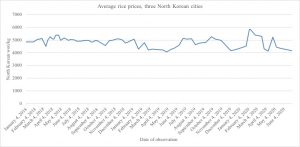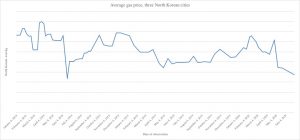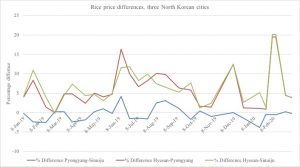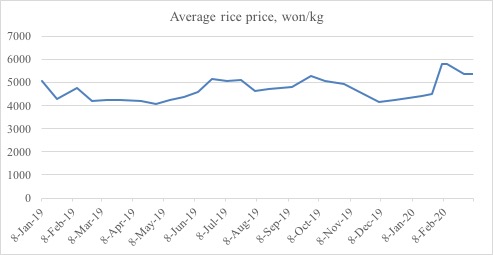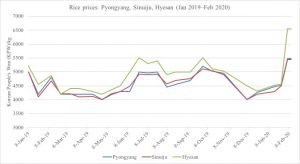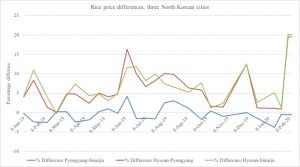By: Benjamin Katzeff Silberstein
(This is a rather long post with two parts: the first analyzes some recent events suggesting a government crackdown against the market economy, while the second recaps the some recent events within this trend. For readers interested primarily in the latter, I suggest scrolling down to the subheading “The events: a brief recap” below.)
Is the North Korean government cracking down on the market economy as such?
I would argue that we are not quite there yet, but an ever-increasing number of news seem to be suggesting that economic policy may be going in this direction. It’s also entirely possible that there is in fact no coherent strategy. One should not overestimate governments in general when it comes to coherence – this is nothing unique to North Korea. Nonetheless, these developments are crucial to keep a close eye on.
This post goes through some of the most central developments over the past few weeks below, but in short, some of these events are:
- the general rhetoric and personnel politics from Kim Jong-un over the past year or so, repeated statements from high official organs about the need for economic control (most recently in a politburo meeting on November 30th),
- the crackdown on foreign currency use and the reported execution of a foreign currency trader,
- a reported change in the management of general markets to greater centralization and direct state control,
- and last but not least (for now), an amendment to the enterprise law, effectively placing a common form of private enterprise under state scrutiny and administration.
This list is by no means exhaustive. For example, North Korean academic journals, often good proxies for what’s cooking in the policy circles, have repeatedly emphasized the need to “create an administrative system” since late last year. In North Korean parlance, this is likely code for increased state oversight and control. (Hat-tip to my good friend and colleague Peter Ward, perhaps the most thorough and dedicated researcher of North Korean journals in the analyst community.)
As I write more about in a forthcoming article for 38 North, the state has placed a high priority on reigning in – and at the very least, governing and administering – the market economy for some time, and with heightened intensity since the 2019 December plenum in particular.
There may, however, be more to it. There still is not sufficient evidence to conclude that the state is actively trying to stomp out markets or market mechanisms as such, but it is a possibility.
First, a basic question: if there is a general crackdown going on against the market economy, what would be the purpose? Again, no one knows, but one can speculate about a few different possibilities.
Perhaps most basically, North Korea is still, at least nominally and theoretically, a communist state with a centrally planned economy. Legally, private property does not exist. There has yet never been an official, explicit, major break with this model. We have often taken the state’s reluctance to crack down on the markets, and indeed, its occasional embrace of market mechanisms, as tacit acceptance that they are in the North Korean economy to stay. Maybe this assumption was wrong all along, or maybe things have changed over the past couple of years.
On the same theme, let’s not forget that North Korea’s political and social system is highly totalitarian. It is only natural that it would tend towards greater control, ultimately aiming to either eradicate or (more likely) tame groups such as the donju and integrate them into the official system. Economic reform and liberalization will always be potentially threatening, as they expand a sphere beyond state control, whether it be in the economy or society overall. Perhaps the North Korean leadership thinks the limit has been reached and it is time for a general rollback.
There may also be a pragmatic purpose to it all. As I have argued before, growing resource scarcity is a likely driver for increased economic control by the state. This is perhaps the most charitable and optimistic reading, as it suggests that the trend may one day be reversed.
Whatever the case, this is all troubling. The state and Kim Jong-un personally may very well be overestimating the capacity and potential of the state economy as an alternative to the market sphere. North Korea is a state with relatively capable governance in some areas, but with a very low capacity in others. Quite likely, the state simply has little grasp of the size of economic activity, and little overview of what this activity consists of. (See, for example, this recent report by Daily NK about a general survey of firms and enterprises leading up to the Party Congress in January 2021.) The border closure due to Covid-19, among other examples, shows that the state is prepared to accept a high degree of suffering among the general public for the purpose of social stability.
The events: a brief recap
The latest data point came a couple of days ago, at the latest of a staggering eleven politburo meetings this year. The KCNA summary contains two highly concerning paragraphs (my emphasis):
”The meeting discussed and studied as key agenda items the issue of hearing a report on the preparations for the 8th Congress of the WPK and taking corresponding measures, the issue of reorganizing a relevant department mechanism of the Party Central Committee to strengthen the field of the Party ideological work, to more thoroughly establish the Party’s leadership system in relevant institutions and to intensify policy guidance and Party guidance over them and important issues of improving the Party guidance over economic work and carrying out immediate economic tasks. Then decisions were made on them.”
And:
”The Political Bureau of the Central Committee of the WPK harshly criticized the economic guidance organs for failing to provide scientific guidance to fields under their charge under the subjective and objective environment and the prevailing conditions, and for failing to overcome subjectivism and formalism in their work. It stressed the need to put the operation and command for carrying out the Party’s economic policies on a scientific basis and display great dedication and responsibility.”
(Source: “Enlarged Meeting of 21st Political Bureau of 7th Central Committee of WPK Held,” Korean Central News Agency, November 30th, 2020.)
This comes against the backdrop of several similar statements from the politburo and other organs through the year and, not least, worrying measures, such as the reported execution of a foreign currency (among other measures) trader amid a strange appreciation of the won against the US dollar. Maeil Kyungje:
“코로나19 확산에 위기감이 높아진 김정은 북한 국무위원장이 `비합리적 대응`을 하고 있는 것으로 보고됐다. 방역 위기에 경제적 어려움이 겹친 상황에서 환율 급락을 이유로 평양의 환전상을 처형하고 바다에서 어로와 소금 생산을 금지하는 등 무리한 조치를 취하고 있다는 것이다.
국회 정보위원들은 27일 국가정보원에서 최근 북한 동향을 이같이 보고받았다고 밝혔다. 정보위 야당 측 간사인 하태경 국민의힘 의원은 “김 위원장이 과잉 분노를 표출하고 있으며 상식적이지 않은 조치를 내놓고 있다”고 평가했다. 이날 국정원 보고에 따르면 김 위원장은 지난 10월 말 `평양의 거물 환전상`을 처형했다. 북한 내 환율이 최근 들어 급락했는데 이에 대한 책임을 물어 비공개 처형했다는 것. 북한은 외화난이 상시화했지만 국경 봉쇄로 외화 수요가 줄어 환율이 급락한 것으로 보인다. 하 의원은 또 “바닷물이 코로나19로 오염되는 것에 대한 우려 때문에 (김 위원장이) 어로와 소금 생산을 금지했다”고 말했다.”
(Source: Park Jae-wan, “Kim Jong-un executes foreign currency trader amid plunge in exchange rate,” Maeil Kyungje, November 27th, 2020.) See this Financial Times article for an English-language summary of events.
And then there’s the recent sudden appreciation of the won. Bill Brown explains this well here. It is, however, part of a broader push for people to use less foreign currency. There could be a whole host of reasons for this move, one of which could be to drive more of it out of circulation and into state hands. We still know too little to draw any firm conclusions.
Daily NK also reported a couple of weeks ago about new measures to centralize control over general markets under Party control. The report did not suggest direct measures to curtail market activity per se, but this may well be the consequence should the measure be fully implemented, with more red tape and central management further from the ground.
North Korea’s KCNA recently ran an article about two bills adopted by the Supreme People’s Assembly. One of them — a ban on smoking in certain areas — got quite a bit of attention, which lighter news from North Korea often does. The second one — an amendment to the country’s enterprise law — is, however, potentially much more significant, and could significantly curtail and hamper private business activity in the country. Here is what KCNA (5/11/2020) said about it:
”The amendments and supplements to the enterprise law newly point out such matters as of turning enterprises into labour-, energy-, cost-, and land-saving ones and making their employees patriotic working people who possess the spirit of economy as part of their mental qualities.
They also refer to the regulations which all the units must observe when organizing new enterprises or when changing their affiliations and those designed to ensure that production and business management are done on socialist principles under the unified guidance and strategic control of the state.”
Now, these few sentences reveal relatively little about what this could all mean in practice. Daily NK reported a few days later, however, that the government aims to centralize control of small business usually operating illegally, known as “kiji”, under official SOE frameworks. Corruption is certainly problematic in general, but given the fact that a massive proportion (or most) of private business in North Korea operates under frameworks that are technically corrupt, the ambition to strengthen government oversight may have serious adverse consequences. (For more on the “kiji” system, see this excellent journal article.)
In conclusion, it is too early to tell what the regime’s end goal is with these measures. At the very least, we can conclude that the state aims to lay more of the economy under its control and management. That is of course a central end goal in itself.

